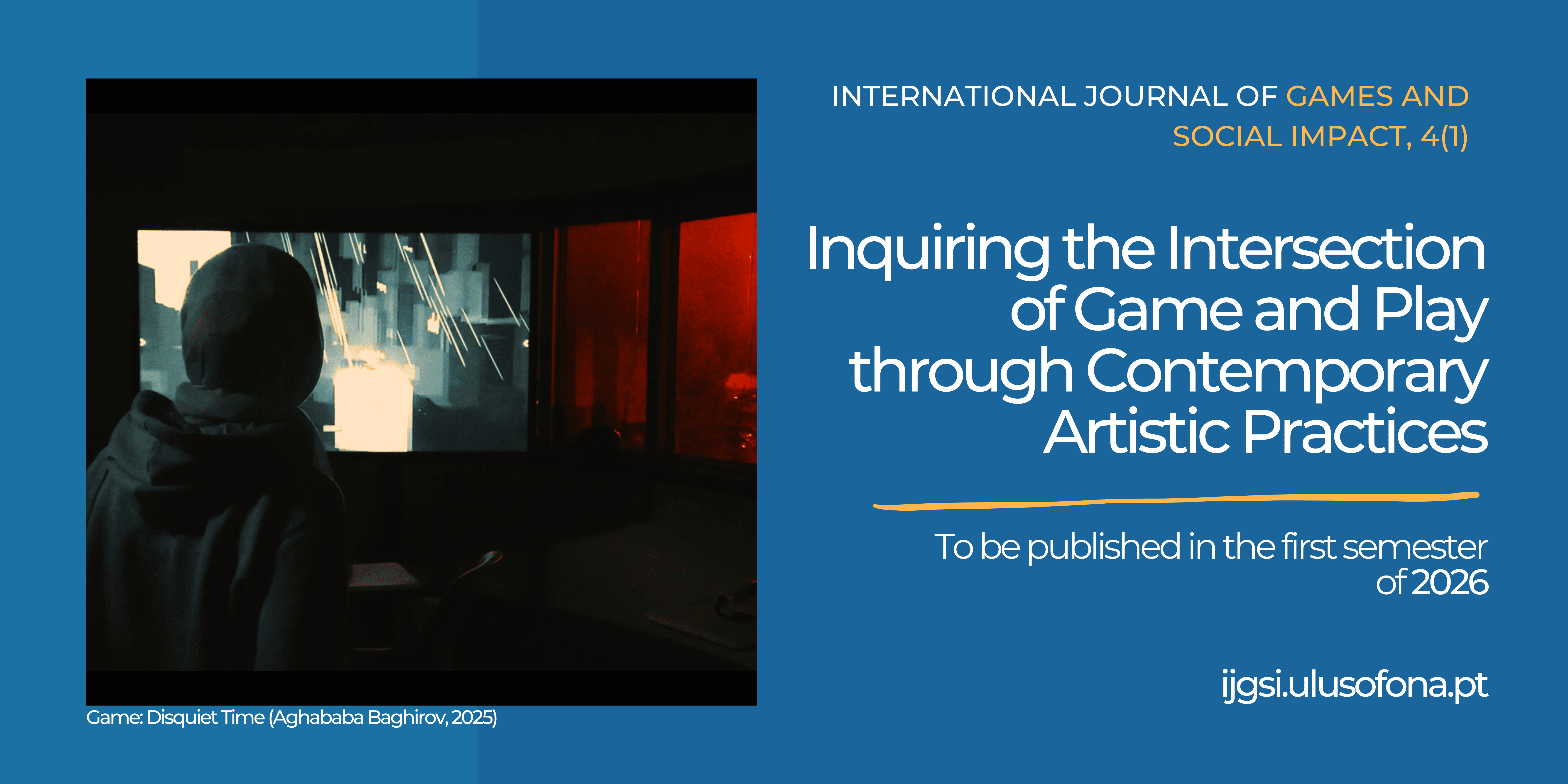Call for Papers IJGSI Vol. 4, No. 1 (2026)

(OPEN)
Call for Papers IJGSI Vol. 4, No. 1 (2026)
Editors:
Hugo Barata (Lusófona University, CICANT)
Rui Antunes (Lusófona University, CICANT)
Contemporary art often draws from popular culture, yet it remains distinct in its values and objectives. While entertainment thrives on dynamic mobility, art engages with forms and ideas. Are these two cultural phenomena fundamentally separate? Jacques Rancière (2019) describes the contemporary artist as oscillating between the production of forms and images and their critique, questioning the radicalism of their power. He illustrates this duality through two exhibitions held in 2000: Let’s Entertain in Minneapolis and Au-delà du spectacle in Paris. The title of the American exhibition invited visitors to engage with art free from critical seriousness, subtly distancing itself from the entertainment industry. Meanwhile, the title of the French exhibition referenced Guy Debord’s theorization of play as the active counterpart to passive spectacle.
From machinimas to interactive installations utilizing game engines, games have increasingly entered the white space of the museum. How has art absorbed and been transformed by games? How have institutionalized artistic images and iconography been integrated into gaming culture?
The rapid evolution of digital technologies (Molnár & Szűts: 2019) has transformed the framework of game design, positioning it as a significant medium for artistic exploration and critical commentary (Díaz & Tungtjitcharoen: 2015). Underlining the motivational inversion referred to by Nguyen (2018), game mechanics, narrative structures, and visual aesthetics can challenge traditional artistic paradigms and foster new modes of interaction, the development of pedagogical tools and creative strategies. Games are not merely a trivial and arbitrary entertainment, but a powerful instrument that can influence cultural perceptions and social behaviors. By working on the intersection of game design and contemporary artistic practices (Smuts: 2005), and their profound impact, it’s possible to highlight how games can serve as tools for change, fostering community engagement, promoting empathy, and addressing challenges through groundbreaking design and collaborative artistic expression. In this perspective, it's possible to analyze the opportunity of motivated playfulness, the layers of intervention via game design and art’s autonomy, the crossing of aesthetics of games and art for social and ethical revolutions, and finally games as social apparatuses for change.
Via a wide-ranging research on contemporary game design methodologies, this call aims to investigate the role of artistic practices in shaping game experiences and social narratives, in the same way that it wants to contribute to a multidisciplinary dialogue that examines the convergence of art in game design through its theoretical, practical, and methodological dimensions.
Submissions may address (but are not limited to) the following questions:
- In what ways can games be considered a legitimate form of artistic expression?
- How can interdisciplinary approaches enhance our understanding of the relationship between Games and Art?
- What potential exists for collaboration between artists and game designers to create innovative and socially impactful experiences?
- What role do emerging technologies, such as virtual reality and artificial intelligence, play in shaping the future of games as an art form?
- How have advancements in technology transformed the horizon of game design and artistic expression?
- In what ways can games challenge stereotypes and promote inclusivity?
- How do the mechanics of games contribute to their potential as a medium for cultural critique?
- How have historical games been influenced by artistic practices?
Authors are encouraged to address one or more of the following topics:
- Video games in museums and cultural equipments
- Games as a methodology for artistic creation
- Historical perspectives on games and social practices
- Future directions in game design and art
- Speculations on the future of games and artistic innovation in social impact
- The influence of narrative design on player experience and social commentary
- Community engagement, collaborative practices as social commentary
- Strategies for inclusive game design, cultural representation and diversity
- Ethics in game design and art
- The effect of globalization in gaming industry and artistic strategies
- Interactivity and player agency
- The impact of virtual reality (VR), augmented reality (AR) and artificial intelligence (AI) on artistic practices and game design
- The role of gamification in enhancing educational experiences and cultural critique
- Psychological and emotional impact of games
Submission Guidelines
Submissions should adhere to the journal’s formatting and referencing guidelines. Both full research articles (6,000-8,000 words) and shorter position papers (2,000-4,000 words) are welcome. All submissions will undergo a double-blind peer review process to ensure scholarly rigor and originality.
Full papers must be submitted electronically after registering on the platform, respecting the guidelines established in the Submissions section.
Publication Timeline
Submitted manuscripts should not have been published previously, nor be under consideration for publication elsewhere. Dates are indicative.
Full Paper Submission Deadline: 15-06-2025
Notification of Acceptance for Full Paper Submissions: 16-10-2025
Publication Date: First semester of 2026
MORE INFORMATION - Here
Fees are not requested for submission or processing.
